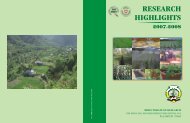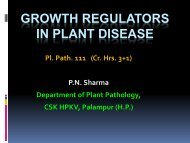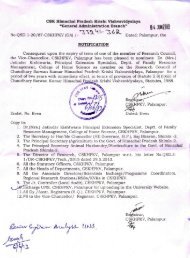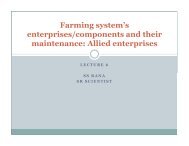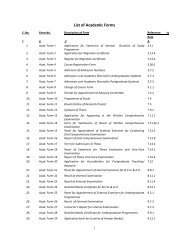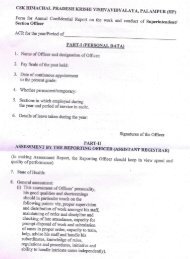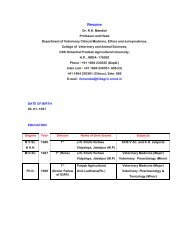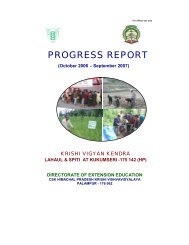animal production - CSK Himachal Pradesh Agricultural University ...
animal production - CSK Himachal Pradesh Agricultural University ...
animal production - CSK Himachal Pradesh Agricultural University ...
Create successful ePaper yourself
Turn your PDF publications into a flip-book with our unique Google optimized e-Paper software.
vi) Care of breeding males: Feed them like that of young breeding males but with more quantities of roughages and<br />
concentrate mixture as they have grown in size with more weight. Provide moderate to heavy exercise depending upon the<br />
conditions of <strong>animal</strong>. Half an hour running will keep them fit for breeding. Feed the male ad lib., two months before the<br />
breeding season as their feed intake is reduced during breeding season. In case of bucks, hairs around urethra should be<br />
trimmed at least once in a breeding season.<br />
vii) Care of breeding females: After calculating the approximate date of parturition from the last date of service on<br />
the basis of average pregnancy period of 150 days, the <strong>animal</strong> should be separated from rest of the flock at least 20 days<br />
before the expected time. The <strong>animal</strong> should be housed in clean and well bedded pen. As the <strong>animal</strong> approaches near<br />
parturition, it is evident from diminished or lost appetite, distended and shiny udder, loosening of genitals, depression near<br />
the root of the tail, pawing and chewing the bedding and bleating. Close watch and the presence of an experienced person<br />
is necessary. The process of parturition is normal kidding. But if it takes unnecessary long time, help of the veterinarian<br />
may be obtained. The <strong>animal</strong> should be given luke warm water to drink followed by warm wheat meal. The soiled bedding,<br />
expelled afterbirth etc. should be removed from the pen.<br />
viii) Care of milking dairy goats: The udder of the goats should be washed with luke warm water containing few<br />
crystals of potassium permaganate. The <strong>animal</strong> should be milked with full hand method.<br />
Housing: The goat should be managed under intensive management (completely stallfed) system or semi-intensive<br />
management (partly grazing and browsing and supplementary concentrate mixture feeding in the pens) system, depending<br />
upon the area and availability of the pasture facilities.<br />
Provide cheap and clean house with thatched roof made of locally available material and thorny fences. Space<br />
requirement for an <strong>animal</strong> as recommended by ISI may be adopted for construction of the house (Fig.2).<br />
Kind of <strong>animal</strong> Floor space required(sq.m)<br />
Adult female 1.0<br />
Adult male 3.3<br />
Young stock 0.4<br />
Fence height should be 1.5 to 2.0 metre. The thickness should be 20 to 30 cm (if made up of thorns), or dog-proof<br />
barbed wire fencing up to the same height as given above would be sufficient.<br />
Selection of ram:<br />
SHEEP PRODUCTION<br />
A breeding ram should be healthy, sound, musculine in appearance. It should possess all the desirable characters<br />
of the breed. It should have strong legs and sound feet, wide brisket and fleshy. The joints should be broad and<br />
quarters thick and full.<br />
Selection of ewe<br />
A breeding ewe should have roomy hind quarters and well formed udder. It should have strong motherly instinct<br />
and should have plenty of milk so that the lambs grow fast. For mutton quality, lambs born early in the season should be<br />
selected as they grow bigger than those born later. They should have more muscle than bones. Those lambs that attain<br />
good weight at the age of 4 to 5 months yield more profits. The quality of mutton from lambs at weaning is of best quality.<br />
Re<strong>production</strong><br />
Estrous cycle in ewes varies from 17-19 days with an average of 18 days. Estrus remains for 21-39 hr. though it<br />
may vary from 1-3 days. Unlike other farm <strong>animal</strong>s, ewes in general do not come in heat at regular intervals throughout the<br />
year. There are three main breeding seasons (1) March-April or summer season (2) June-July (sometimes June to August)<br />
or autumn season and (3) October - November or winter season. Nearly 15-20% ewes come in heat in summer, 60-80% at<br />
the beginning of autumn and a very small number in winter. The gestation period varies from 142-152 days with an average<br />
of 146 days.<br />
23



